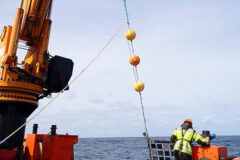It’s vital that fishermen make their views known in a fishery with significant French interest, and where anglers take over a quarter of the catch
By Andy Read
The Bass Fishery Management Plan (FMP) for England and Wales differs from the other ‘fast- track’ FMPs currently out to consultation in several respects. Perhaps reflecting its value to the angling sector, the original proposals for the FMP were developed by the government Policy Lab, rather than by Seafish or the MMO.
Its approach was to host a mixture of online and in-person meetings, online questionnaires and discussion groups, in a bid to agree aims and objectives for the FMP. There were separate sessions for commercial fishermen, anglers and environmental interests.

A drop in recruitment after a series of good year-classes in the 2000s saw a fall in the size of the bass stock, with radical steps taken in 2015 to reduce the volume of landings.
The outcome is an FMP long on aims, but very short on concrete proposals, with few hard choices made, and decisions postponed until the full results of that consultation process are analysed.
The consultation documents include a 131-page Environmental Report, an Impact Assessment, the FMP itself, and an online survey asking a series of basic questions, for those who wish to respond quickly without the need to go into details.
Few fishermen will disagree with the broad aims of the FMP: to provide fair access to the fishery for stakeholders, but also to ensure long-term sustainability. It seeks to find ways to ensure better compliance with existing and any new measures to protect the stocks, associated habitats and possible bycatch species.

News on the stock in recent years is more positive, with SSB recovering, and reports from all around England and Wales of unprecedented numbers of one- and two-year-old bass showing up in estuaries and other nursery areas. A major ICES benchmarking exercise over the next 12 months should provide detailed evidence of the state of the stock, covering all of English and Welsh waters.
There are, however, a few tantalising questions that offer the suggestion that this FMP could yet see far-reaching changes to the management of the fishery. Depending on your viewpoint, these could be either a threat or a real benefit.
One possibility causing alarm to commercial fishermen is the long-mooted suggestion about introducing a ‘slot’ for bass that can be retained, with a maximum as well as a minimum landing size.
Alternatively – in a fishery segmented between three fishing methods, with very different discarding profiles – there is the potential to remove any discards ban, in a bid to gain a better understanding of the true level of catches across different sectors, including the French fleet, which figures suggest took 15% of the bass caught in English and Welsh waters in 2021.
The FMP also raises the potential of either changing the closed season, currently February and March, or introducing different seasonal closures on a regional basis, to better reflect the spawning and migratory patterns of stocks.

Even at a two-fish-per-day limit, scientists reckon that hobby fishermen took 27% of bass landings in England and Wales last year. Anecdotal evidence from commercial fishermen around the coast suggests that illegal ‘recreational’ landings – such as this one detected earlier this month by Cornwall IFCA officers – are widespread. The FMP consultation asks specific questions about adherence to catch limits, and how best to police the management regulations. (Photo: Cornwall IFCA)
The FMP and associated Environmental Report also make much of potential impacts of bass fisheries on species such as migratory salmonids and cetaceans. With measures to protect sea trout, salmon and shad being pushed by the Environment Agency – including the closure of inshore net fisheries, not just for bass, but for species such as red mullet and mackerel – an increased understanding of the impacts of these fisheries could potentially see IFCAs reversing moves to limit inshore netting.
So there is a lot to play for. What is clear is that with such a diverse array of commentators likely to have their say on this fishery, it is vital that all commercial fishermen with an interest make their views known.
Since numbers first jumped 20 years ago, bass have provided a welcome new outlet for many fishermen (other than those unlucky enough to have missed out on the original reference period for netters and hook and line fishing in 2015-16).
The survey tacked on to the consultation provides little in the way of suggestions or ideas to comment on. After you’ve entered personal details, there are only 10 substantive questions. The key to helping this FMP develop into a sustainable and enforceable fisheries management regime will be for fishermen to add detail to their answers in the space provided.
The consultation and supporting documents can be found here.
The consultation closes on 1 October.
‘Maximum size limit is a real threat’
A well-known Dorset bass team who rely on the restaurant demand for large rod and line-caught bass provide their take on the proposals…
By Ian and Annie Gilbert
We’ve read through the FMP, and on the whole most of what is being proposed to protect stocks – nursery areas, catch and gear restrictions – is already in place.
There are a few areas of great concern to us, and I expect to the rest of the commercial rod and line fleet. Our biggest worry is the input that the recreational anglers will be allowed, an influence way beyond their actual numbers.
Recreational angling is a dying sport – the number of people participating has plummeted. Twenty years ago there were 28 charter boats in Poole. That is down to just five and a handful of part-timers. It is the same story in Weymouth, which is regarded as having one of the largest charter fleets in the country – there are just a third of the boats that there used to be 20 years ago. There are currently charter boats for sale everywhere.
My point is that the various angling bodies are still using the flawed calculations made by Cefas in 2012 that there are 880,000 sea anglers in this country generating £3bn in revenue – people are still making decisions based on these figures. Our worry is that this minority group of anglers will have a disproportionate amount
of input into the coming FMP.
They have every right to have their views included, but it has to be in proportion.
We also have very real concerns about the introduction of a maximum size limit. This could have a disastrous impact on our income and financial viability. A large chunk of our income comes from restaurant- sized fish that are over 2kg in weight. In the autumn, over 50% of our catch is made up of these fish. If we were no longer allowed to keep fish of this size, the rod and line fishery would not be viable. These big fish can fetch double the money that the smaller 1kg to 2kg fish get.
The rod and line fishery is on a knife-edge as it is. If we were to catch our full 6,200kg annual quota (which we don’t) and we were to average £10 per kilo, that would give us a gross income of £62,000. Our running costs each year come to nearly £30,000 – that doesn’t leave much for two people. If our average price were to drop to £7 because we were not allowed to keep the bigger fish, our income would not be viable, even if we could make up the shortfall of larger fish by catching more small ones – which we couldn’t manage.
We welcomed the increased MLS that was designed to let every fish spawn before it is caught. Stock levels recovered after the introduction of the current rules. Clearly removing these larger fish in the rod and line fishery is not hurting stocks, and it is providing a sought-after resource to restaurants available from nowhere else.
Personally I feel that quotas should be left as they are; we should be kept below 8t a year, the recreational anglers should be kept to two fish, and a sensible bycatch allowance should be given to the netters/ trawlers.
The two-fish limit for recreational anglers put a stop to illegal selling of bass almost overnight. We had a huge problem in Poole with a small fleet of private boats landing huge quantities of bass to unscrupulous merchants – within a year, all the boats had been sold. The problem of black- market bass has almost gone. There are still anglers who sell their fish, but the two-fish rule makes it more difficult.
The bass fishery does need a plan to keep it sustainable, and to keep prices at a level that supports a low-impact fishery. A lot of what has been suggested in the FMP makes sense – it just needs people with the correct knowledge to turn it into a cohesive and workable plan for the future.
We would urge every bass fisher to respond to the consultation and make their views known. There will be an organised campaign from the angling lobby that could put our livelihoods at risk – without benefiting the stocks.
‘Vital that fishermen have their say’
NFFO chair Paul Gilson has called on all fishermen with an interest in the bass fishery to respond to the consultation, underlining how vital this stock is to a healthy inshore industry in England and Wales.
“I can’t overstate the importance of the bass fishery, which I am hearing from fishermen across the country is booming. We’ve reports of juvenile fish everywhere, and larger bass available to be caught from the beach, from piers, by net, by rod and line, by trawl.
“We urgently need to understand better the full size of the stock, and just how far it is spreading, and we very much welcome the benchmarking exercise proposed by ICES, with many fishermen offering to provide inputs on what they are seeing at sea.
“I’ve heard from many members – and urge other fishermen to follow suit – of the importance of showing Defra officials and Cefas scientists just how widespread the stock now is, both mature fish and juveniles. It’s vital not only that fishermen respond to the consultation, but provide their information to it, including what they are seeing on the grounds, and the levels of fish that they could take if they were allowed to land them.
“There are some real issues at local level that are impacting fishermen in some inshore districts. The FMP may also be a real chance to bring in some national-level management that improves things locally.”
This story was taken from the latest issue of Fishing News. For more up-to-date and in-depth reports on the UK and Irish commercial fishing sector, subscribe to Fishing News here or buy the latest single issue for just £3.50 here.
Sign up to Fishing News’ FREE e-newsletter here.






